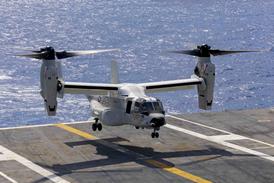The US Navy is considering adding conformal fuel tanks (CFTs) onto its fleet of Boeing F/A-18E/F Super Hornet strike fighters, sources say. The twin dorsally mounted tanks are expected to be tested this summer.
The USN does not deny that it is interested in the conformal tanks, but says that it cannot comment on the project at this time. "As of right now this information is proprietarily owned between Boeing and Northrop [Grumman] and PMA-265 cannot talk to it," the Naval Air Systems Command says. PMA-265 is the US Navy programme office responsible for managing the F/A-18 and EA-18G fleets.
Boeing officials did not respond to queries prior to publication.
 |
|---|
US Navy |
The CFTs, which Boeing has pitched to potential buyers as part of its Super Hornet international roadmap, would allow the F/A-18E/F to carry more than 1,590kg (3,500lb) of additional fuel. "Adding these tanks would make a great deal of sense," says Mark Gunzinger, an airpower analyst at the Center for Strategic and Budgetary Assessments. "The navy really needs to extend the reach of its carrier air wings. Increased range will be needed for potential operations in the Pacific region and elsewhere."
The USN's efforts to add CFTs might be part of the service's plan to hedge its bets in case of further delays to the Lockheed Martin F-35C, or if budgetary pressures force the navy to abandon that variant. "At this point, the F-35C is easily the most troubled variant," says Richard Aboulafia, an analyst at the Teal Group. The USN has always been lukewarm toward the stealthy single-engined fighter even if senior service leaders always publicly profess that the service "needs" the F-35C.
But there are questions as to whether the Super Hornet can support the added weight and drag of the CFTs without seriously impairing its aerodynamic performance. "One problem with CFTs on the F/A-18 is that I'm not really sure it has the power," Aboulafia says. "If they put CFTs on the [Boeing] F-15 and [Lockheed] F-16, they're fast jets. But the Super Hornet is already pretty much slowest in class."
Boeing officials have previously said that the addition of the CFTs does not add any cruise drag, but they admit that the appliqué fuel tanks would have a negative impact on the aircraft's transonic acceleration because of the increased waved drag. Transonic acceleration has always been a weak spot for the Super Hornet, and many pilots say the aircraft is seriously underpowered compared to other fourth-generation fighters. "You're talking about something that impairs its performance for an aircraft that already has some performance issues," Aboulafia says. "But it might be worth it, given the issue of finding an alternative to the F-35C. It's certainly worth experimenting with."
If the USN were to add CFTs to the F/A-18E/F, it might also have to upgrade the aircraft's twin General Electric (GE) F414-GE-400 afterburning turbofans which produce 22,000lbs (98 kN) thrust each, Aboulafia says. GE has previously touted an enhanced performance engine (EPE) variant of the F414, which could produce 26,400lbs (120 kN) thrust. It would, however, require a redesigned fan and a new high pressure core. But Aboulafia questions if GE can deliver on those promises. "I'm not sure how much more thrust you can get out of that series," he says. "Maybe there is a bit more they can go that would give them the power."
But given the US government's current financial situation, the USN may not be able to pay for a programme to add CFTs to the Super Hornet. "It will be difficult to start a new programme for this anytime soon," Gunzinger says. Aboulafia says that is true, but money could potentially be siphoned from the USN's F-35 accounts. "For a few people at least, especially the navy, the F-35 is as much a potential bill-payer as it is an acquisitions programme." Funding for the tri-service stealth fighter has been a bone of contention between the US Marine Corps and the blue-water navy for quite some time, Aboulafia says.
Source: Flight International























